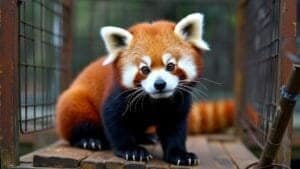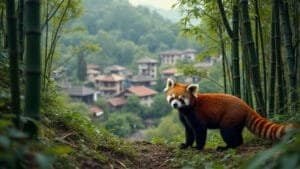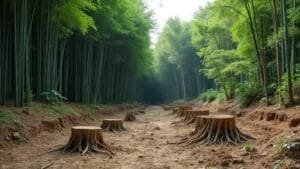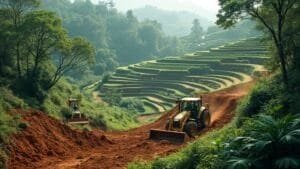Red pandas depend almost entirely on bamboo forests for their survival, making the degradation and loss of these ecosystems one of the most serious threats they face. With nearly 95% of their diet composed of bamboo leaves and shoots, any reduction in bamboo availability directly affects their ability to find sufficient nutrition. But bamboo loss does more than just reduce their food supply—it fragments their habitats, isolates populations, and exposes them to increased risks from predators and human activity
In this article, we explore the multifaceted impact of bamboo forest depletion on red panda survival. We’ll examine the specific bamboo species they rely on, how flowering cycles and climate change influence bamboo growth, and what conservation efforts are underway to restore and protect these vital habitats
The Critical Role of Bamboo in Red Panda Diet and Habitat

Bamboo is more than just a food source for red pandas—it forms the ecological foundation of their survival. These arboreal mammals are adapted to temperate forests of the eastern Himalayas and southwestern China, regions where bamboo grows in abundance beneath the forest canopy. As both a nutritional lifeline and a structural component of their habitat, bamboo shapes red panda behavior, distribution, and overall health. When bamboo forests are depleted or disrupted, red pandas lose more than just a meal—they lose the very framework of their ecosystem
Red Panda Dependence on Bamboo for Nutrition
Red pandas have a highly specialized diet, with bamboo accounting for approximately 95% of what they eat. They consume tender bamboo shoots, young leaves, and stems, relying on these parts to meet their daily energy requirements. Despite being carnivores by classification, red pandas have evolved to digest this low-nutrient food source, although they extract only about a quarter of the energy from what they consume. Because of this low efficiency, red pandas must spend a large portion of their day eating—typically ingesting up to 20,000 bamboo leaves, or the equivalent of 2 to 4 pounds of bamboo daily
This dietary reliance leaves red pandas particularly vulnerable to any changes in bamboo availability. When bamboo is scarce or declines rapidly—as during flowering die-offs or habitat loss—red pandas may face starvation, as few suitable dietary alternatives exist in their ecosystem. In contrast to giant pandas, which are known to consume a wider range of bamboo species, red pandas are more limited in their dietary preferences and thus less adaptable to environmental changes that affect bamboo abundance
Essential Bamboo Species for Red Panda Survival
The red panda’s dependence on bamboo is not generalized across all species but is closely tied to specific varieties found within its native range. In Nepal and eastern India, key bamboo species such as Yushania maling and Thamnocalamus spathiflorus provide the preferred shoots and leaves that red pandas feed on. These species thrive in montane ecosystems and form the dense undergrowth that red pandas rely on not only for feeding but also for cover and denning
These bamboo species tend to grow in discrete belts along mountain slopes, and their presence strongly influences where red pandas establish territories. Because red pandas are territorial and solitary, the availability and spatial distribution of bamboo stands can directly limit the number of individuals a habitat can support. When preferred bamboo varieties are cleared or degraded, red pandas may be forced into suboptimal habitats, leading to increased competition, reduced health, and even local extinctions
Bamboo Flowering Cycles and Food Shortages
Bamboo flowering events are a natural, but potentially devastating, part of the red panda’s ecological reality. Many bamboo species exhibit a phenomenon called “gregarious flowering,” where large areas of bamboo flower simultaneously and then die off en masse. This process can occur on cyclical timelines—ranging from every 15 to 120 years depending on the species—but when it happens, it leads to temporary food shortages for animals that rely heavily on bamboo, including red pandas
While natural ecosystems may recover over time from these events, the recovery process is hindered in areas where forests are already fragmented or degraded. Without healthy surrounding stands to repopulate flowering zones, regrowth may be slow or incomplete. For red pandas, this means the loss of entire feeding territories and, in worst-case scenarios, the abandonment of critical habitat
In addition to natural cycles, climate change may be altering the timing and intensity of bamboo flowering, creating further unpredictability in red panda food supply. Combined with the stressors of habitat fragmentation and human activity, even a temporary bamboo shortage can become a life-threatening crisis for red panda populations
These interdependencies illustrate how central bamboo is not just to the diet, but to the entire life history and ecology of the red panda. For more on how bamboo-based ecosystems are being preserved and connected, the Red Panda Network’s feature on conservation corridors highlights how reforestation efforts are helping restore food access and connectivity across fragmented landscapes
Human and Environmental Drivers of Bamboo Depletion

The rapid decline in bamboo forest coverage across red panda habitats is the result of a combination of human activities and environmental changes. These pressures not only diminish the availability of bamboo but also disrupt the broader forest ecosystems that red pandas rely on for food, shelter, and breeding. Understanding the specific drivers behind bamboo depletion helps clarify the urgent need for targeted conservation strategies aimed at reversing these trends
Agriculture, Grazing, and Deforestation Impacts
In regions where red pandas live, particularly Nepal, India, and Bhutan, human encroachment into forested landscapes is one of the primary causes of bamboo depletion. Expanding agriculture, road construction, and infrastructure development lead to the direct clearing of bamboo-rich forests. In rural communities, bamboo is also harvested for use as building material, fuel, and fodder—uses that, while traditional, have become unsustainable due to population growth and limited forest management
Livestock grazing further accelerates bamboo forest degradation. Domestic animals, especially cattle and goats, feed on young bamboo shoots and trample seedlings, preventing natural regeneration. This overgrazing results in patchy, degraded landscapes where red pandas struggle to find the dense bamboo thickets they require. The cumulative effect of grazing, harvesting, and deforestation is a fragmented environment where bamboo is sparse and unevenly distributed, isolating red panda populations and reducing overall habitat quality
This fragmentation is especially problematic for a species like the red panda, which is known to avoid open areas and prefers thick forest understory for movement and foraging. In landscapes where bamboo has been cleared or reduced to small, isolated patches, red pandas are often forced to travel greater distances or abandon former habitats altogether. These changes reduce population density, limit mating opportunities, and increase the species’ vulnerability to predation and human conflict
Climate Change Effects on Bamboo Forest Stability
Environmental changes driven by climate change are compounding the impacts of human activity. Rising temperatures and altered precipitation patterns are shifting the altitudinal range where bamboo can grow, particularly in montane regions where red pandas reside. As the ideal climatic conditions for bamboo move upward, there is often no suitable land left above the current tree line to accommodate new growth, resulting in a net loss of bamboo habitat
Furthermore, increased frequency of droughts, storms, and landslides—events linked to climate instability—can cause both direct destruction of bamboo stands and long-term soil degradation that prevents regrowth. These climate-induced disturbances are particularly harmful in already-fragmented ecosystems, where recovery relies heavily on remaining bamboo corridors and healthy root networks to restore vegetation
Red pandas are also indirectly affected by the ecological instability brought on by climate shifts. When their habitat becomes too hot or dry, or when bamboo forests become sparse and unreliable, the species must shift its range, which may bring it into greater contact with human settlements, livestock, or predators. These movements increase their risk of poaching, roadkill, and other anthropogenic threats
Scientific studies have warned that even a modest rise in temperature could shrink suitable red panda habitat by more than 35%. This habitat loss includes the degradation of bamboo belts, which serve as their exclusive foraging grounds. Thus, climate change does not just reduce the area of available bamboo—it actively reshapes the ecological systems on which red pandas depend, making conservation more urgent and more complex
A strong example of the intersection between environmental and human-driven threats can be found in WWF’s overview of red panda habitat degradation, which highlights the rate of bamboo forest loss and its cascading impact on wildlife
Conservation Efforts to Protect and Restore Bamboo Forests

Given the red panda’s reliance on bamboo forests for survival, the protection and restoration of these habitats have become central pillars of conservation strategy. Across the eastern Himalayas, organizations and local governments are investing in projects that not only protect remaining bamboo stands but also restore degraded areas and reconnect fragmented landscapes. These efforts aim to create healthier ecosystems that can support stable red panda populations well into the future
Habitat Restoration and Reforestation Initiatives
Reforestation is one of the most direct and effective ways to combat bamboo forest depletion. In Nepal, the Red Panda Network is leading extensive habitat restoration projects focused on planting native bamboo species and restoring degraded corridors between forest patches. Their “Plant A Red Panda Home” campaign, for example, works with local communities to grow and transplant bamboo seedlings in areas affected by logging, grazing, or erosion
These restored corridors not only improve food availability but also allow red pandas to move safely between forest patches. Movement corridors are critical for maintaining genetic diversity, expanding territories, and reducing isolation—factors that directly influence the species’ resilience to environmental changes and disease. By restoring connectivity in red panda range areas, conservationists can reverse some of the most harmful effects of habitat fragmentation caused by bamboo loss
Beyond replanting, forest management practices have also shifted to include bamboo-specific considerations. Conservation groups now prioritize the sustainable harvesting of bamboo and educate communities on the importance of allowing bamboo groves to regenerate naturally. This includes rotational harvesting techniques, selective cutting, and protection zones around red panda nesting sites
Several protected areas in India, Bhutan, and China have integrated bamboo preservation into their core conservation plans. National parks like Singalila and Neora Valley have implemented grazing bans and fire control measures to protect bamboo from degradation. Such protected zones serve as refuges for both red pandas and other species that share the bamboo understory
Community Involvement in Sustainable Forest Stewardship
At the heart of red panda conservation is the involvement of local communities—those who share space with the species and whose livelihoods are closely tied to the forest. Community-based conservation has proven highly effective in protecting bamboo ecosystems. By offering sustainable alternatives to deforestation and providing direct benefits from conservation work, programs can shift behavior at the grassroots level
The Red Panda Network’s Forest Guardian program exemplifies this approach. It hires local individuals to patrol forests, monitor red panda populations, and ensure that bamboo habitats remain intact. These guardians are also trained in ecological data collection and community outreach, helping to educate others about the role of bamboo in maintaining a healthy forest ecosystem
Educational programs and school outreach have helped shift local perceptions of bamboo from being a simple resource to a keystone species critical to red panda survival. Conservation leaders often engage women’s groups, youth clubs, and religious institutions to spread awareness and promote stewardship across all levels of the community
Alternative livelihood projects—such as eco-tourism, handicrafts, and bamboo nursery cultivation—provide economic incentives to reduce deforestation and promote forest restoration. These programs allow communities to benefit from healthy ecosystems without degrading them, turning conservation into a shared goal rather than an external imposition
Digital engagement has also become a valuable tool. Campaigns such as International Red Panda Day and interactive conservation apps have increased public awareness globally and locally, helping build a sense of pride and responsibility in protecting red panda habitats












